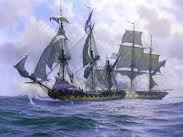The 31st December 2020 marks the 300th anniversary of the birth of Prince Charles Edward Stuart. To commemorate this special occasion the West Highland Museum has organised a series of articles written by scholars, academics, authors, and Jacobite enthusiasts. In this fourth in the series, author Angus MacDonald takes a closer look at the arrival of Jacobite gold in Lochaber in 1746.
The Lost Jacobite Gold
The article below about the landing of the gold for Bonnie Prince Charlie is from the ‘yet to be published’ novel provisionally called Westering Home by Angus MacDonald, author of the Ardnish trilogy. Set in Cape Breton, Nova Scotia in 2016, it follows the grandson of the last Gillies of Ardnish coming to visit his old family home. The adapted section below is historically pretty accurate.
Prince Charles Edward Stuart, the heir to the King of Scotland was in exile in Rome. He had been led to believe that there was considerable support for him over here and, encouraged by Lord Lovat, MacDonald, MacLeod and other Clan Chiefs and with the promise of backing from Spain and France, he and his Seven men of Moidart landed in the loch to the North of Ardnish, Loch nan Uamh. Clans gathered to support him at Glenfinnan and within six months he had taken Edinburgh and was leading his army deep into England. It was at that point that things started to go wrong. The English Jacobite support that was expected didn’t materialize, the French and Spanish army didn’t invade England nor send funds as had been promised and the clansmen started to drift off home. So he returned north and on April the Sixteenth 1746, Jacobite hopes were crushed at Culloden, ending with Bonnie Prince Charlie fleeing abroad once again.
The French gold did arrive, but not until two weeks after Culloden, when the Prince was moving from cave to cave to avoid being captured by Government troops. On the Third of May 1746, two French frigates sailed into Loch nan Uamh. They were called the Bellone and the Mars. They were believed to have 36,000 gold coins Louis d’or, (worth c.£10 million today) plus guns and supplies for the Jacobite army and clearly, they had not heard of the massacre at Culloden Moor.

Close behind them were three English Naval ships and of course, a proper sea battle broke out, with cannon shot pounding into each other, causing a huge number of deaths and holing the Mars badly below the waterline. It’s said that the beach below Arisaig House and along the cliffs of Ardnish was crowded with spectators.
‘You can imagine the scene, the ship lying on its side, beached. Ship’s carpenters hacking out the shattered planks with axes, men cutting new spars to fit and tar being boiled to waterproof her. Men trying to splice a new mast on to the broken stump of the old one and sodden sails lying out to dry over the rocks. Above the waves the Ardnish people would have heard the cries of injured men being operated on by the ship’s surgeon, having vast wooden splinters removed or limbs sawn off and instructions being bellowed back and forth from the various work parties. They would be rushing to finish by the time the tide came back in. Dozens of men had been killed; their bodies washing up on the shore for weeks afterwards.’
‘It’s widely believed that the Mars unloaded its cargo while it was on the shore, but history doesn’t relate which beach the frigate had been repaired on and certainly, the gold has not been found – that anyway knows about anyway. Perhaps it’s buried on an island alongside Loch Arkaig or on an island in Loch Eilt – there are so many theories and rumours.
Apparently a week after that sea battle, a Royal Naval ship, under command of a man called Fergussone came sailing into Loch Ailort looking for The Prince. As the boats were rowed to the shore, the young Clanranald chief gathered men about him and they fired at the attackers. The villagers fled into the hills and the thatched roofs of Peanmeanach were torched.
It was announced in November 2020 that a group of amateur archaeologists called Conflicts of Interest discovered a stash of musket balls and coins, almost certainly from the skirmish, on the North side of Loch nan Uamh. The treasure still awaits.
Angus MacDonald
